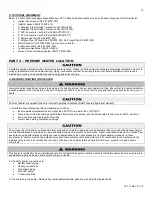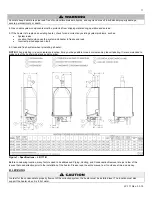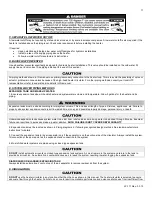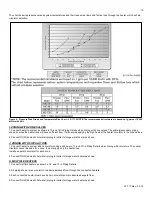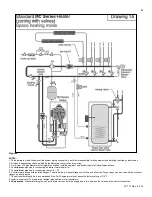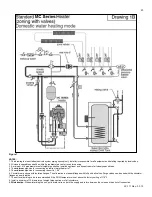
8
LP-171 Rev. 3.3.15
Water pH between 6.0 and 8.0
o
Maintain water pH between 6.0 and 8.0. Check with litmus paper or have it chemically analyzed by water treatment
company.
o
If the pH differs from above, consult local water treatment company for treatment needed.
Hardness less than 7 grains
o
Consult local water treatment companies for unusually hard water areas (above 7 grains hardness).
Chlorine concentration less than 100 ppm
o
Using chlorinated fresh water should be acceptable as levels are typically less than 5 ppm.
o
Do not connect the heater to directly heat swimming pool or spa water.
o
Do not fill heater or operate with water containing chlorine in excess of 100 ppm.
*NOTE:
It is recommended to clean heat exchanger at least once a year to prevent lime scale buildup. To clean the heat
exchanger, follow the maintenance procedure in Part 15, Section B of this manual.
Hardness:
7 grains
Chloride levels:
100 ppm
pH levels:
6-8
TDS:
2000 ppm
Sodium:
20 mGL
G. WINTERIZING
NEVER
use any toxic chemical, including automotive, standard glycol antifreeze, or ethylene glycol made for hydronic (non-potable)
systems. These chemicals can attack gaskets and seals in heaters, are poisonous if consumed, and can cause injury or death.
Consider piping and installation when determining heater location.
To winterize the heater, drain the entire system. Then apply air pressure to the drain valve and allow air and water to escape from the
purge valve (see piping instructions).
Once you have evacuated as much water as possible, pump non-toxic, NSF food grade propylene glycol, FDA rated as GRAS
(Generally Recognized As Safe), into the system. Consult the glycol manufacturer for specific instructions on concentration percentage
as well as freeze and burst protection methods. Check the volume and concentration of antifreeze to assure protection is adequate to
protect the entire system from freezing. When pumping, allow air and remaining water to escape from purge valve. When the stream
coming out of the purge valve matches the color of the non-toxic glycol, the system is adequately filled.
Finally, it is recommended to start the circulation pump and allow the system to circulate for at 30 minutes to completely blend any
trapped water that might be in the system with the glycol.
PART 2 – BEFORE YOU START
A. WHAT’S IN THE BOX
Also included with the heater:
Temperature and Pressure Relief Valve
Pressure and Temperature Gauge
Intake PVC Tee with Screens
Exhaust PVC Coupling with Screens
Plastic hose and Instructions for Purging Heat Exchanger
Installation Manual
Warranty
B. HOW THE HEATER OPERATES
Modulation Condensing Technology
is an intelligent system that delivers highly efficient water heating, while maximizing efficiency
by measuring the data parameters of your system.
Stainless Steel Heat Exchanger
The highly efficient and durable stainless steel heat exchanger is designed to extract the last bit of energy from flue gas before it is
exhausted.
Содержание MC120
Страница 21: ...21 LP 171 Rev 3 3 15 M PIPING DETAILS Figure 5 ...
Страница 53: ...53 LP 171 Rev 3 3 15 Figure 30 ...
Страница 71: ...71 LP 171 Rev 3 3 15 Figure 34 ...
Страница 72: ...72 LP 171 Rev 3 3 15 Figure 35 ...
Страница 73: ...73 LP 171 Rev 3 3 15 Figure 36 ...
Страница 76: ...76 LP 171 Rev 3 3 15 ...
Страница 77: ...77 LP 171 Rev 3 3 15 ...
Страница 78: ...78 LP 171 Rev 3 3 15 MAINTENANCE NOTES ...










